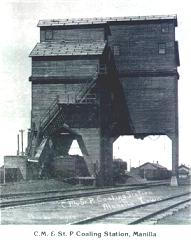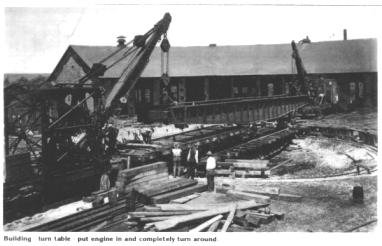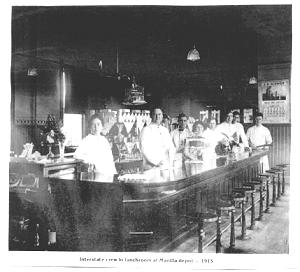Manilla's Beginning
Newspaper Article 1886 ~ Newspaper Article 1887
Railroad History Reprint from Manilla Times 1952
All was quiet and peaceful in Astor until one day some strangers appeared - railroad officials - people soon found out. A short cut to Sioux City was their aim. The question was were they going to build from Astor or Defiance? It was soon found out they were going to build a new town just two miles east of Astor. The railroad bought W.L. Paup's farm, had it surveyed, and lots were staked out. The sale of lots was held in November and $13,000 worth of lots were sold. Houses sprang up like mushrooms overnight.
You can imagine the excitement this brought to Astor. The townsmen were bewildered, then decided they had better move to the new town. Residents of Astor put their business places and homes on wheels and moved to the new town, the moving being done with horses, mules, and oxen. It was a lot of hard work. They soon lined up along the new main street with corn stalk and fodder under their feet. Instead of a gold rush, it was a rush for the new town. With stores still on stilts, they were ready for business. The two blacksmiths, Palmer and Brown, were the first to leave Astor and move their places of business. Their business was necessary for the building of the new railroad as it took many horses, mules, and equipment. A box car served as depot and freight house in one. It was a bit crowded but was all they had.
E.H. Hanne was the first grocery store to move to the new town. It was located where the Memorial Hall now stands.
The new town did not as yet have an official name. In 1885, Astor celebrated the Fourth of July and one of the program features was a tug-of-war. Since the new town did not have a name, they decided to name it with the tug-of-war contest. There were some who thought the town should be named after Les Paup (who owned the land before the railroad bought it). They wanted it called Paupville. Until this time, grain had been bound by hand, but the self-binder had just been invented. With it a twist had to be used. Mr. Blackburn's Hardware store in Astor was sending out circulars advertising the new twine, called Manila Binder Twine. Mr. Blackburn furnished a Manila rope for the tug-of-war and suggested the town be named Manilla. Some of those pulling for Manilla were Cash Crakes (father of Grace Schram), Ad Morgan (Cicero Morgan's father), Luke Tillet, Charley Schroeder, and two others. Those pulling for Paupville were Ed Saunders (father of Harry Saunders), Charles Saunders (father of Chuck Saunders), Will Theobald (father of Ed Theobald), and three others. There are those who wonder how Manilla got its two L's. This seems to have happened at the recording of the town name.
The post office at Manilla was established at the opening of the town. The first postmaster was G.W. Brokaw. In 1886, the postmaster at Astor resigned for nearly all the residents had moved to Manilla.
Manilla was growing. The Methodists of Manilla purchased lot 12 in block 15 and hoped to move the Astor church to Manilla. The Manilla Methodist Church was dedicated May 22 with W.T. Smith the presiding elder of the Council Bluffs District in attendance. The pastor was H. Linn. The Presbyterians purchased lot 2 in block 15 and started to raise money to build a church. Mrs. S.M. Neely, a member, went to Denison for help in furnishing the church. Large hanging lamps were donated by H.C. Laub, J.P. Miller, Schlumberger & Wrigley and Dr. Wilkinson; Paul Mahler, who had a shoe store, gave chandeliers for 2 lamps; Mr. Garrison, a large pulpit bible; the following donated money for a table to be used as a pulpit, Goldheim , J.G. Wygant, D.W. Shaw, A.H. McAhren, C.P. Stocking and W.D. Luney.
By May of 1887, 200 buildings had been erected in Manilla. The year before, it had been a corn field. A dozen buildings were still under construction. An official of the Chicago, Milwaukee and St. Paul Railroad purchased 240 acres at $40.00 an acre. Then he laid out lots on a portion of it and received from $500.00 to $1000 for each lot. The Manilla Newspaper, which was called the Register, was upstairs over Gleisters' store. Mr. Baer was the editor. His wife set most of the type. Next was a church, the Presbyterians, followed by the Methodists, who constituted the most active evangelical church in the west. Next came a school. Here, trouble arose. The nearest school building was two miles from town. Suddenly 100 children clamored for admission. There was no money in the city treasury to build. The Presbyterians church was leased. A curtain partition was hung across the room and two teachers put to work. M.N Smith had charge of the Union Hotel in Manilla, doing a rushing business. He had over 35 borders. The people of Manilla talked of incorporation. At the September term of District Court the Judge appointed T.J. Garrison, and E.K. Burk of Denison, A.L. Barrett, F.S. Garleck and G.W. Baer of Manilla to hold an election. In early October 1887 the people of Manilla, by a vote of 93 to 13 decided to incorporate. There were by now 200 families in Manilla, 25 business houses, 3 churches and a nice hall 22 x 60. The town also boasted of a brass band. I.W. Callimore was the first mayor of Manilla.
The Presbyterians built a new building where the Presbyterian manse now stands. The Chicago, Milwaukee, and St. Paul railway presented the lot for the building. This Church was used by the town for a school until a building for education could be built. In 1889, school district no. 6 and no. 7 were combined to form an independent school district and a new school house was built. It contained four classrooms. Some of those who started first grade the fall of 1889 in the new school were Effie Flint Beck, Minnie Steckleberg Miller, Gertie Browkow Schram, and Emil Lueth.
The first doctor in Manilla was Dr. J.B. Gardner. The doctor's territory was Buck Grove, Aspinwall, Botna, Irwin, Defiance, and Manilla. They traveled by horse team and buggy or sleigh.
In 1889, the Manilla Community subscribed donations to build a community building which was first called "Germania Hall" and later "The Manilla Opera House".
In 1891, the town suffered an epidemic of Diphtheria, resulting in the death of many children. Many families lost several children. School was closed for some time.
The Manilla National Bank was organized in 1887 with S.F. Smith as President.
In 1882, a waterworks was built.
A city hall was erected in 1894 at a cost of $3000.
The Nishnabotna township in which Manilla now resides was named by the Indians thus; Ni-sna-bo-te-na meaning "Creek where they make boats".
Contrast, if you will, that during this decade long distant telephone was just established between New York and Chicago. It didn't arrive in our village until around 1901. However, the Manilla Times was established in 1899. Other newspapers throughout the years were Manilla Enterprise, Manilla Register, Manilla Advocate and the Republican Monitor.
RAILROAD HISTORY AS MANILLA KNEW IT FOR 116 YEARS
1886
The railroad caused Manilla's being in 1886.
The railroad was Manilla's life line and the towns biggest employer in its heyday. On the Chicago, Milwaukee, St Paul and Pacific, (CMSTO&P) line.

|
Thousands of train passengers passed through Manilla going to or from Omaha, Nebr. and Chicago, Ill. Thousands more went from Manilla north to Sioux City, Iowa and beyond. |
 C.M. & St. Paul Coaling Station |
1967
On June 1, 1967 the last passenger train between Omaha and Chicago went thru Manilla.
 |
1968 In August of 1968 the original Manilla depot was dismantled. 1968 |
1980
In early 1980 the Burlington Northern Santa Fe took over ownership of the Milwaukee tracks.
In December 1980 the line from Manilla to Sioux City was officially abandoned and the track was torn up.
2002
The Burlington runs a stub line from Council Bluffs, Iowa through Manilla to Bayard, Iowa hauling grain.
In 1952, 60 local men handled 800 freight and passenger cars daily.
In 2002 nobody living in Manilla is a railroad employee.

Building - turn table - put engine in and complete turn around.

Milwaukee Payroll $14,750 Monthly
(Reprinted from Manilla Times. Issue 1952)
The business that made Manilla, continues to be its leading industry after 66 years. The Chicago, Milwaukee & St. Paul railway employs more men than any other local business and has the largest single payroll per month of $14,750.
An early account of the railroad stated: “The extension of the Chicago, Milwaukee and St. Paul railway to Sioux City in 1886, and the establishment of Manilla as a division station where passengers and freight exchange cars for all points in the Dakotas and the great North- west, was a history-making period of this hand some city of the plains.”
In fact, if it had not been for the Milwaukee Railroad, the birth of Manilla would have been unlikely.
The building of the Milwaukee railroad was started in the southern part of Crawford county in the 1880’s. The first survey was made in the dead of winter, and before the snow was off in the spring the permanent survey was made. In June the actual work of grading commenced.
The road was finished in the spring of 1881 and trains were running on regular schedules by fall. This road established two towns in Craw ford county: one at Aspinwall In Iowa Township, and one at Astor, in Nishnabotna.
A Mr. Morris McHenry once gave the valuable information regarding the location of Manilla. The first line of the railroad was laid from Sioux City to Defiance and was called the Defiance line, The company had run several lines from Defiance to Sioux City and had planned to make Defiance the junction point.
It was through McHenry that the line was finally laid some 10 miles east of Defiance. Up until this time the town of Astor had started very promising conditions and was becoming a lively village. Numerous lines of trade were opened, and the town was of such importance that Denison recognized its value by establishing what was known as the “Astor short cut” road. The people of Astor had just about decided to incorporate when the Sioux City branch of the Milwaukee was surveyed and it was determined to start the extension from a point about two miles northeast of Astor . The new town was subsequently named Manilla.
The people of Astor accepted their fate and a larger part of their town was moved to the new location.
Manilla became the head of the Sioux City division of the Milwaukee. The extensive rail road yards “talked business.” It became the home of a large number of railroad men and their families.
Manilla was known for its very rich agricultural country affording good trade, and it be came important as a railroad point.
The round house had 12 stalls. There were repair shops, coaling station, eating house, night and day switch engines and other adjuncts of a railroad center.
In 1942 the round house was rebuilt and six stalls took the place of the 12; in 1951 one stall was converted into a locker room for the engine men.
Back in 1912, double tracks were laid from Chicago to Manilla but 10 years ago some of the double track was taken out of the main line and in 1944 the big bridge was converted to single track.
The Manilla point which is known as the Iowa and Dakota division still does minor repair work on equipment, C. Rule is car foreman.

Interstate crew in the lunchroom at the Manilla Depot - 1915
There are seven freights daily on the Iowa division and six running daily on the I. and D. division besides a number of extras. As an example of the amount of interchanging of cars here, in a 24-hour period on July 21, 521 cars were received and 319 delivered in the Manilla yard. That is a total of 840 cars that were inter-changed from one division to another.
On July 28 of this week, 817 cars were inter-changed.
Passenger service on the Milwaukee to various cities is as follows:
Hiawatha—from Manilla to Chicago, I. 1:14 p.m. arrive Chicago, 8:25p.m. From Chicago to Manilla, 1v. 11:50 a.m., arrive 6:43 p.m.
Arrow—from Manilla to Chicago, l. 9:50 p.m., arrive Chicago, 8:50 a.m. From Chicago to Manilla, 1v. 6:10 p.m., arrive 5 a.m.
Hiawatha—from Manilla to Sioux City, 1v. 6:59 p.m., arrive Sioux City, 9:08 p.m. From Sioux City to Manilla, iv. 10:55a.m., arrive 12:50
p.m.
Arrow—from Manilla to Sioux City, 1v. 5:30 a.m., arrive Sioux City, 8 a.m. From Sioux City to Manilla, 1v. 6:45 p.m., arrive 9:20 p.m.
Hiawatha—from Manilla to Omaha, lv. 6:56 p.m., arrive Omaha 8:20 p.m. From Omaha to Manilla, lv. 11:55 am., arrive Manilla 1:03 p.m.
Arrow—from Manilla to Omaha, lv. 5:30 a.m., arrive Omaha, 7:30 a.m. From Omaha to Manilla, lv. 7:40 p.m., arrive Manilla. 9:20 p.m.
Service is also available to passengers to Des Moines. Either on the Arrow or Hiawatha, pas- sengers change at Madrid.
The various departments, men and monthly payrolls are as follows:
Round house employees, $3,000: P.D.
Robertson, foreman: Henry Dubrall, Gerald McMahon, Jake Terwilliger, Ed Chistiansen, Vernie Langheim, Gilbert Opperman, Leo Mell, Pete Fancy, Joe Warner, extra. Maintenance, $3,000: Al Whitmer, lineman; R. Ivey, signal maintainer; H. Blair, pump man; Joe Long, pumper. Section, S.C.&D., $900: John McClatchey, Harry Hollander, Ralph Hester.
Section, Iowa, $1,500: William Schroeder, Henry Krantz. Harry Schroeder, Wm. Hollander, Henry Ladehoff, Richard Case, extra, Herman Meiners, extra.
Depot force, $3,850:JJ. McDonald, agent; E. Huffaker, clerk, R,(J. Rutherford, clerk; Wm. Carothers, clerk; V.0. Natzel, clerk; Everett Galiher, operator: C.A. Conklin, operator; Clifford Klein, operator; J.G. Disburg, operator; Don Schroeder, operator; B.E. Capron, train director.
Jess Conlin picks up and delivers for the rail- road.
Car department, $2,500: G.E. Rule, foreman;
C.W. Agan, CE. Agan, T.J. Rowan, Ted Brothers, Fred Saunders, Frank Perry, Bill Chrastil, Jerry Conlin, extra.
The following Manilla men work on the B. & B. crews: Jim Rule, John Bargenquast, F. Mitzel, E. Clause, J. Vrana, Alvin Bandow, B. Cooper, Pete Ritchey, Don Newell. Bob Akers jr., Leonard Akers, Jack Olberding, Wm. Mundt, Melvin Boyens, Don MeIl, Russell Marr, the last two being crane operators.
Those receiving retirement checks are: E.R. Akers, Fred Schram, Hugo Grau, Walt Bryant, Albert Grau, John Thompson, Tony McDermott, Arthur Natzet, Roy Cole, Henry Bargenquast, Mrs. Bertha Disburg, Mrs. Rula Akers and Mrs. Inez Buggington.
